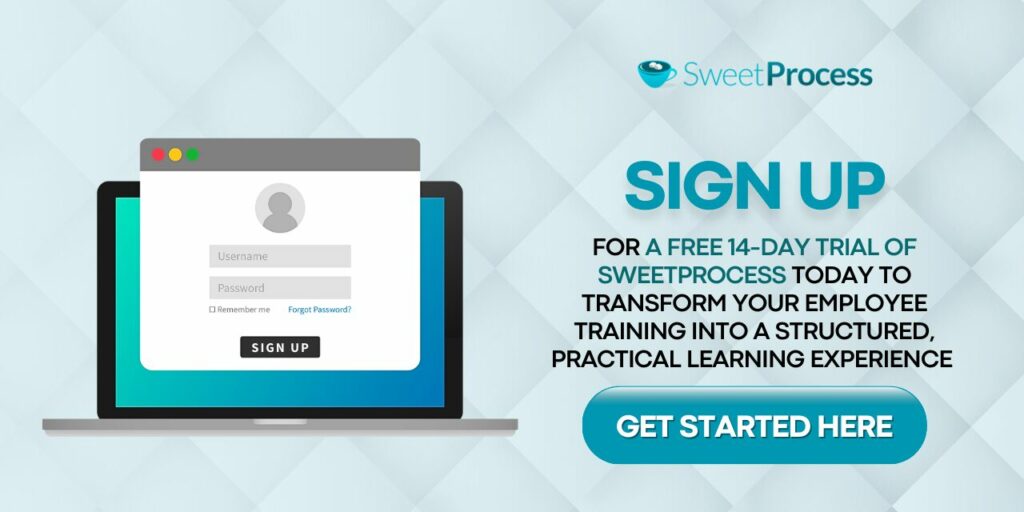Last Updated on April 14, 2025 by Owen McGab Enaohwo

According to Forbes, 67 percent of HR managers increased their learning and development budgets in 2022. Part of this increase is to help them improve their training materials, which include manuals, instructional videos, and interactive modules. Training provides staff with the necessary skills and knowledge to perform their duties efficiently, enhancing overall organizational performance.
Imagine that you log into your learning management system and see that the course completion rate is at an all-time high, and the employee assessment score is all beaming in green. Your CEO praises you for the employee engagement and performance that are through the roof.
This sounds like a perfect dream. But how do you get your business to this enviable height?
Training is the overlooked recipe for increased employee retention, engagement, and performance.
According to Academy To Innovate HR, 76 percent of employees will likely stay with an employer providing training and development opportunities.
If you want a consistent and predictable business success outcome or to transform your employee training into a structured, practical learning experience, sign up for our 14-day free trial today.
Table of Contents
13 Best Practices For Creating Effective Employee Training Materials Ways
How To Create and Manage Training Materials on SweetProcess
Why Are Training Materials Important for a Business
Examples of Training Materials To Create for Your Business
5 Characteristics of Effective Training Materials
Create and Manage Your Training Materials Using SweetProcess
Types of Training Materials

Businesses with effective employee training materials are likely to have a successful learning experience that allows individuals or teams to acquire new skills and knowledge efficiently.
The right combination of materials ensures that learners remain engaged, retain information, and apply what they have learned in real-world scenarios. Below are the primary training materials and best practices for maximizing their effectiveness.
Written Materials (Manuals, Handbooks, Workbooks)
Written materials are essential reference guides explaining processes, policies, and best practices. When well structured and with the correct information, training materials such as manuals, handbooks, and workbooks build a company’s consistency and interactive learning using exercises and case studies.
These materials should be well-organized, concise, and include clear instructions. Visual elements like bullet points, diagrams, and bolded text enhance readability and retention.
Visual Aids (Presentations, Charts, Infographics)
Visual aids break down complex training material to improve employees’ understanding of the organization’s processes and procedures through presentations, which could be in person or virtual; such presentations need to be concise and engaging, using a mix of text, images, and animations to retain attention.
Charts and infographics simplify data and highlight key takeaways, making them visually appealing. Best practices include using high-quality graphics, keeping slides uncluttered, and ensuring color schemes enhance readability rather than distract from the content.
Multimedia Resources (Videos, Podcasts, E-Learning Modules)
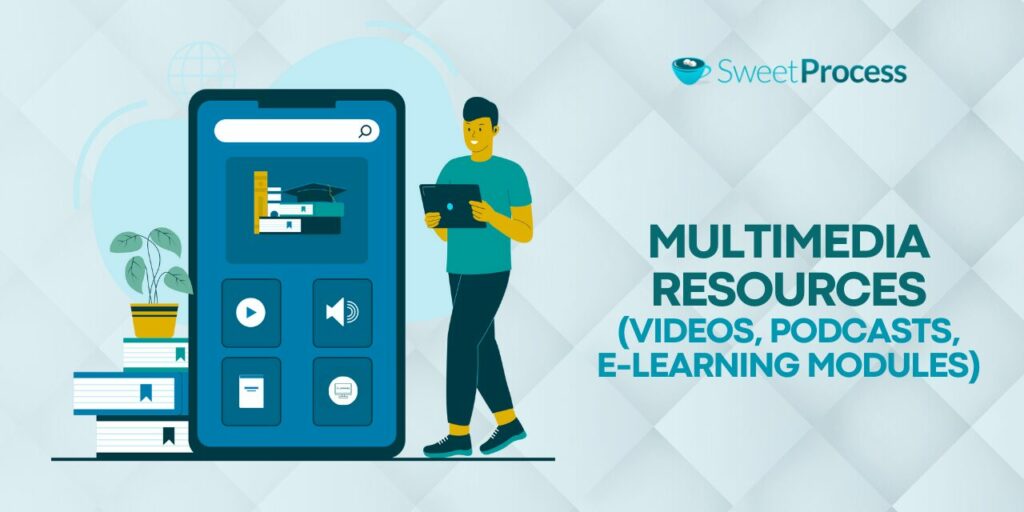
Multimedia resources and training materials are used in different styles to enhance engagement. For example, training videos should be high-quality, concise, and subtitled to help various audiences understand the content of the training material.
The podcast is also one of the other multimedia resources that allows learners to understand the training content on the go. However, e-learning modules enhance interactive experiences with quizzes, simulations, and gamification features.
The multimedia resources’ best practices include access to content across all devices, ensuring high-quality production, and structuring information in bite-sized segments for better retention.
Physical Objects (Models, Equipment for Hands-On Practice)
Physical objects such as models, prototypes, and equipment provide invaluable hands-on experience for skill-based training. These materials allow learners to practice in real-world settings, improving muscle memory and application efficiency. Best practices involve ensuring safety measures, providing step-by-step instructions, and combining hands-on training with theoretical lessons to reinforce understanding.
Digital Tools (Online, Quizzes, Virtual Reality Stimulation, Mobile Apps)
Digital tools and training materials include online quizzes and virtual reality (VR). These digital tools enhance interactive learning experiences, improving engagement and real-time assessment.
Online quizzes provide immediate feedback, which can help reinforce users’ knowledge retention. Virtual reality (VR) simulation, on the other hand, allows learners to engage in a more realistic training system without the associated risk. To maximize effectiveness, these tools should be user-friendly, regularly updated, and aligned with learning objectives.
Forms and Assessment
Forms and assessment training tools like quizzes, surveys, and evaluation forms help foster learning processes by providing feedback, gauging knowledge gaps, and measuring the effectiveness of the training program. These tools should be designed to capture meaningful insights using a mix of multiple-choice, open-ended, and scenario-based questions.
Among the forms and assessments, best practices include keeping assessments brief yet comprehensive, ensuring anonymity where needed, and regularly analyzing results to refine training strategies.
13 Best Practices For Creating Effective Employee Training Materials
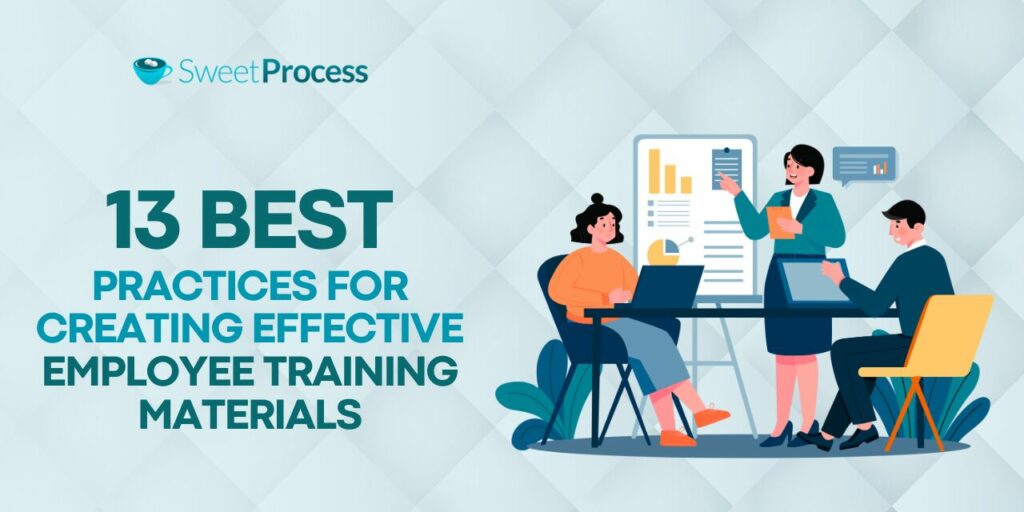
Employee training is paramount for business growth and operational efficiency. Well-structured and engaging training materials boost employee performance and ensure knowledge is consistently communicated across teams.
Here are 13 best practices that’ll help you create effective training materials for your employees.
Clearly Define Learning Objectives
Before developing training materials, outline the key learning objectives. Employees should know exactly what skills and knowledge they will gain. Clearly stated objectives help set expectations and measure training success.
Know Your Audience and Write for Them
Consider your employees’ backgrounds, knowledge levels, and learning preferences. Tailoring training content to their specific needs ensures better comprehension and retention. New hires may need introductory materials, while experienced staff may require advanced content.
Use Accessible, Approachable Language
Avoid jargon and complex terminology. Use simple, clear, and engaging language to make training materials easy to understand. Employees should be able to grasp concepts without confusion or frustration.
Design a Plan
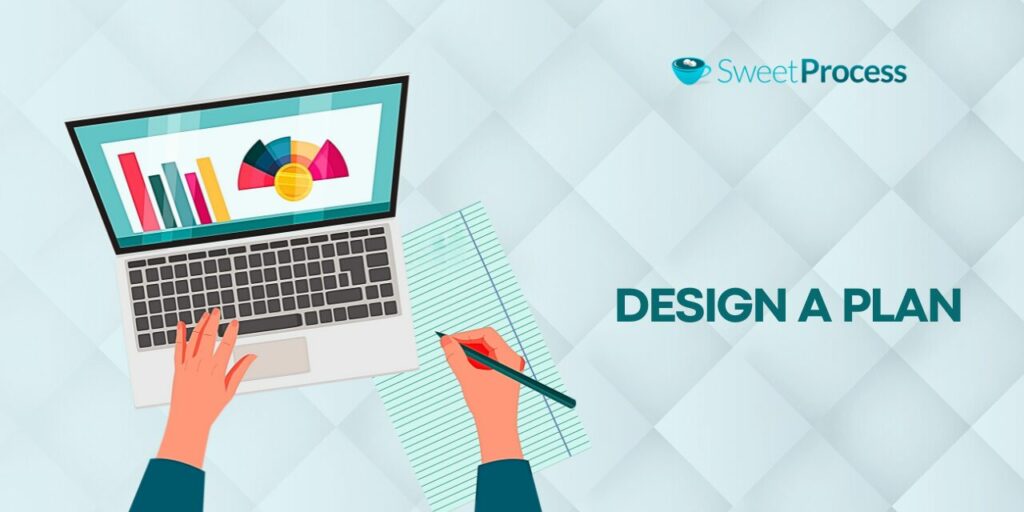
A detailed and well-structured plan ensures that employee training materials are well organized and logically presented. Define the scope, structure, and delivery methods in advance to create a seamless learning experience.
Keep It Short and Break It Up
Lengthy training sessions can be overwhelming. Break down content into smaller, digestible sections. Use bullet points, subheadings, and visuals to improve engagement and comprehension.
Choose the Right Platform
Select a platform that best suits your business needs, whether a learning management system (LMS), video-based training, or interactive e-learning modules. The right platform ensures smooth content delivery and easy accessibility.
Create Engaging Employee Training
Use multimedia elements like videos, infographics, quizzes, and interactive exercises to keep employees engaged. Gamification and scenario-based learning can enhance retention and motivation.
Use Collaborative Tools To Create Training Materials
Collaboration tools like SweetProcess can streamline content creation by allowing multiple contributors to develop, review, and refine training materials in real-time. These tools enhance accuracy and consistency across the organization.
Conduct a Needs and Existing Material Assessment
Evaluate what training materials are already available and identify gaps. Understanding what and where employees need help to create relevant and effective content, avoid redundancy, and ensure efficiency.
Determine the Content
Outline the key topics and concepts that must be covered. Ensure the content aligns with business objectives, employee roles, and performance goals. Use a mix of theoretical knowledge and practical applications.
Iterative Design and Feedback
Gather feedback from employees and stakeholders to refine training materials. Iterative improvements based on real-world applications enhance effectiveness and ensure materials remain relevant.
Proofread It, Read It, Share It
Review all training materials thoroughly to eliminate errors. Test the content by sharing it with a small group before rolling it out company-wide. Peer reviews can help discover inconsistencies in the training materials and improve clarity.
Update and Maintain Regularly
Training materials should evolve with business needs and industry trends. Business owners must regularly update the contents to ensure accuracy, relevance, and compliance with changing regulations and best practices.
How To Create and Manage Training Materials on SweetProcess
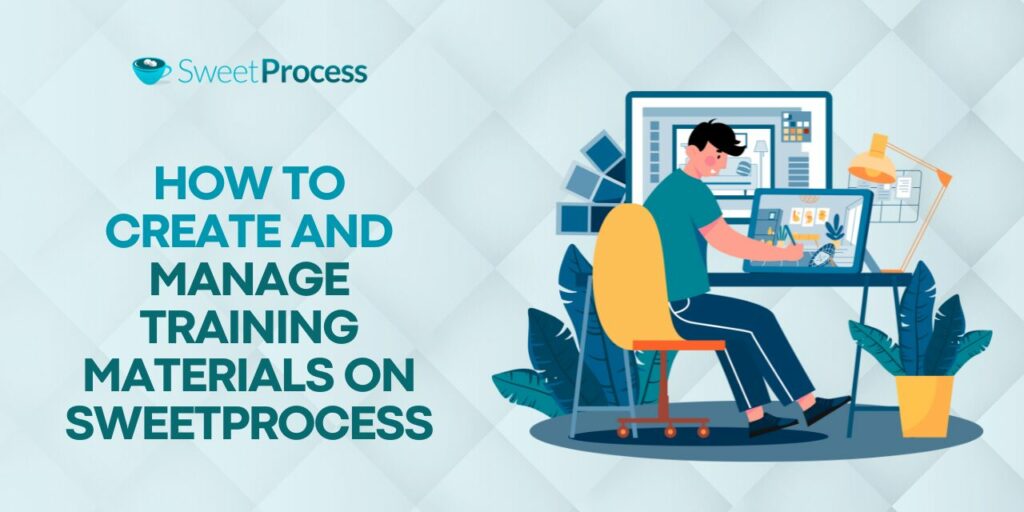
Document Your Company’s Procedures and Processes for Employees
Imagine running a growing IT company where each team member is skilled and dedicated, yet the company struggles with inefficiencies despite their efforts. Tasks are being completed, but not always consistently. Mistakes happen, deadlines are missed, and when problems arise, no one is quite sure who was responsible or how to prevent the issue from happening again.
This was the reality for Next7 IT, a managed services provider that prides itself on delivering top-tier IT support to businesses. Although they have expertise, they lack standardized documentation.
The team relied on scattered Word documents to store procedures and processes, making it challenging to locate the right information when needed. New employees often struggled to understand company workflows, and experienced staff spent valuable time explaining tasks rather than focusing on their core responsibilities.
Without clear, accessible documentation, the company’s staff constantly cycles to complete each task. Team members spent unnecessary time searching for procedures or recreating them from memory. Worse still, accountability was a challenge. When an issue arose, it was difficult to determine if a process was followed correctly or even who had executed it. This resulted in wasted time, operational inconsistencies, and frustrated employees.
After realizing the need for a better documentation system, Next7 IT adopted SweetProcess to manage its processes and procedures. It transformed operations by centralizing all procedures in one easily accessible platform, eliminating confusion and inefficiency.
Here are the exact steps to create your business processes and procedures on SweetProcess so that your employees are not always in a constant state of problem-solving:
Sign up for a 14-day free trial of SweetProcess if you haven’t done so already, log into your account, and click the “Create Procedure” button as shown below.
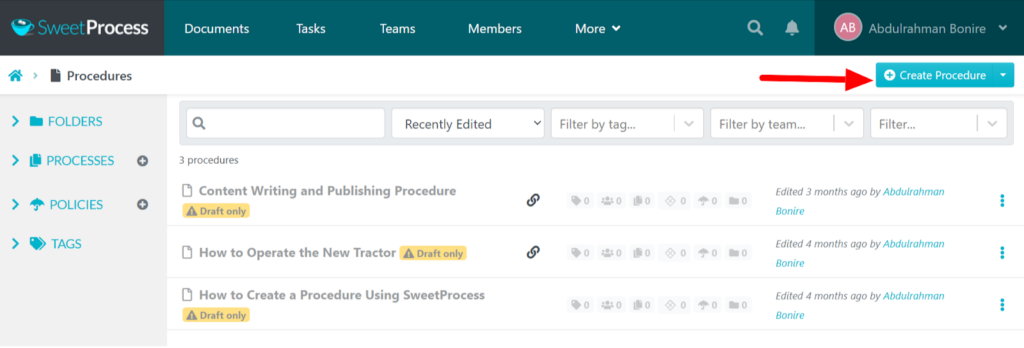
That takes you to the next page where you can give your procedure a title and choose to continue manually or use SweetAI to create your procedure based on your title automatically.
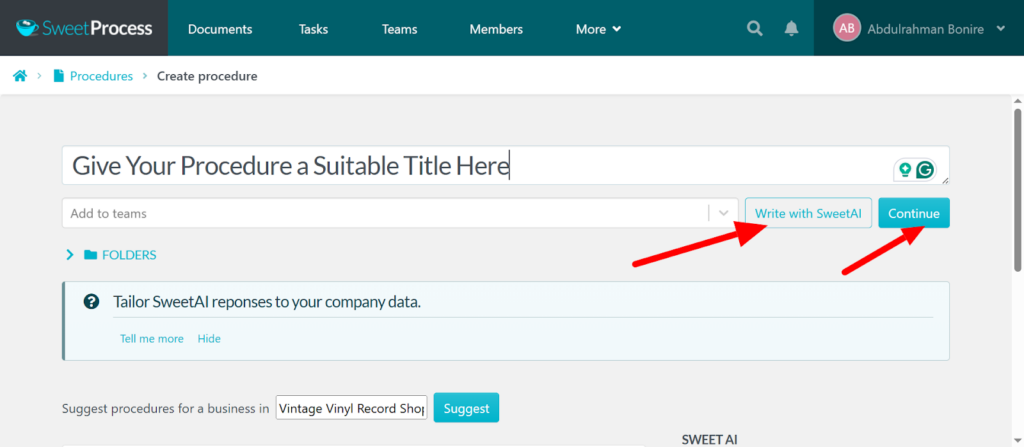
You can create your processes in SweetProcess by combining several procedures.
To create a process, click on the “More” button and click on “Processes” in your sweetProcess account.
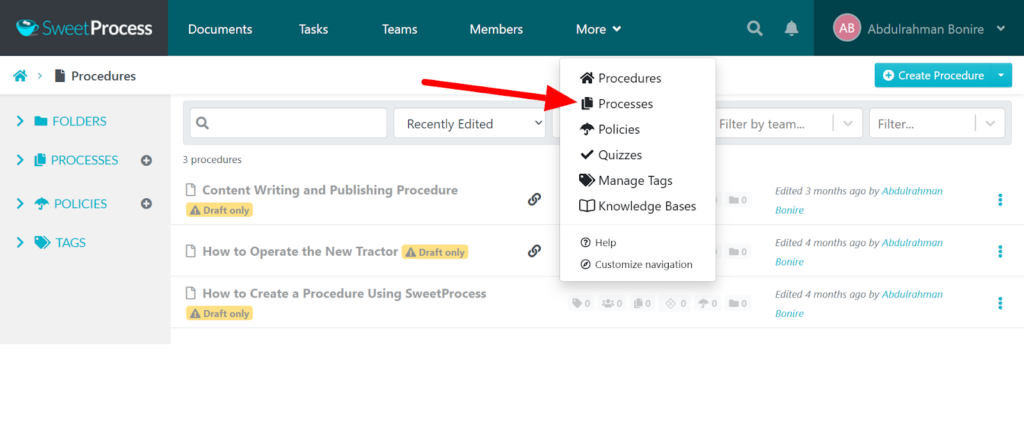
Click on “Create Process,” as shown in the screenshot below.

Next, give your process a title and click “Continue,” as shown below.

You will see a screen displaying your process. Feel free to add existing procedures or create new ones to make up your process.
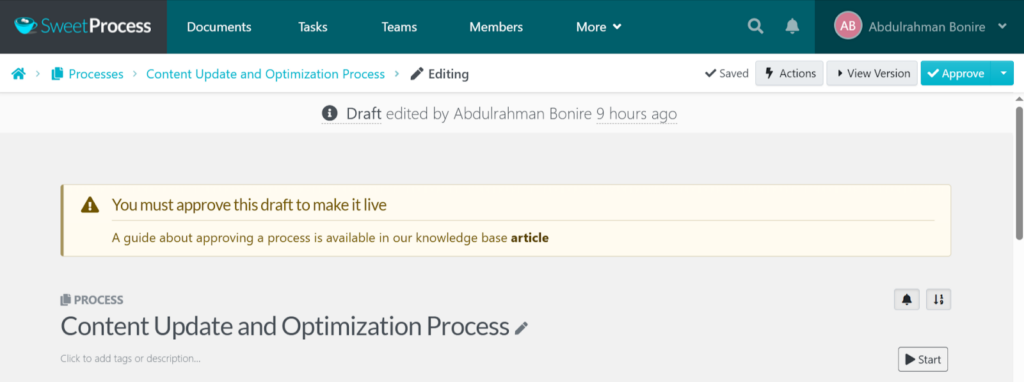
You can order the procedures inside a process and any other form of editing that suits your business needs.
Embed Images, Tables, and Videos Into Your Training Materials

Incorporating images, tables, and videos into training materials significantly enhances comprehension, retention, and engagement. Businesses can easily change complex instructions into more precise, actionable steps.
However, images help new employees visualize every process stage while reducing confusion and improving performance. With SweetProcess, tables can break down intricate processes into digestible components, ensuring clarity and ease of reference.
To add images, tables, and videos to your process and procedure as training materials on SweetProcess, go to your account dashboard and click to edit a process or procedure as shown below.
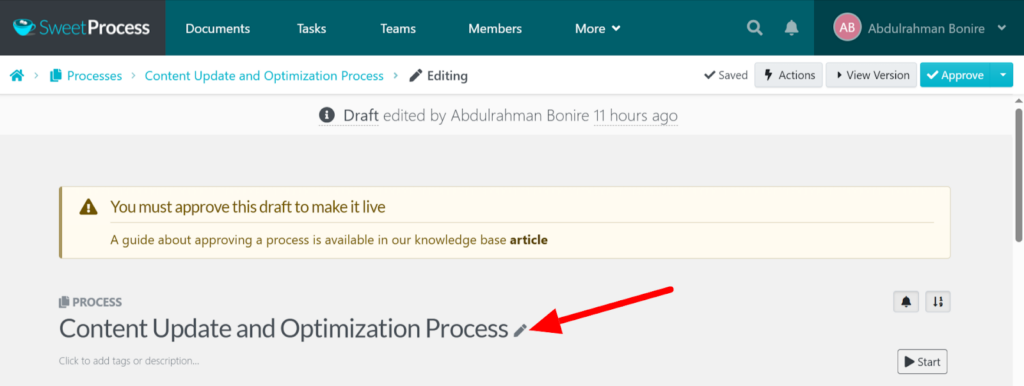
You’ll see a screen similar to the one below, where you’ll be presented with the option to include an image, a video, or a table in your training materials.
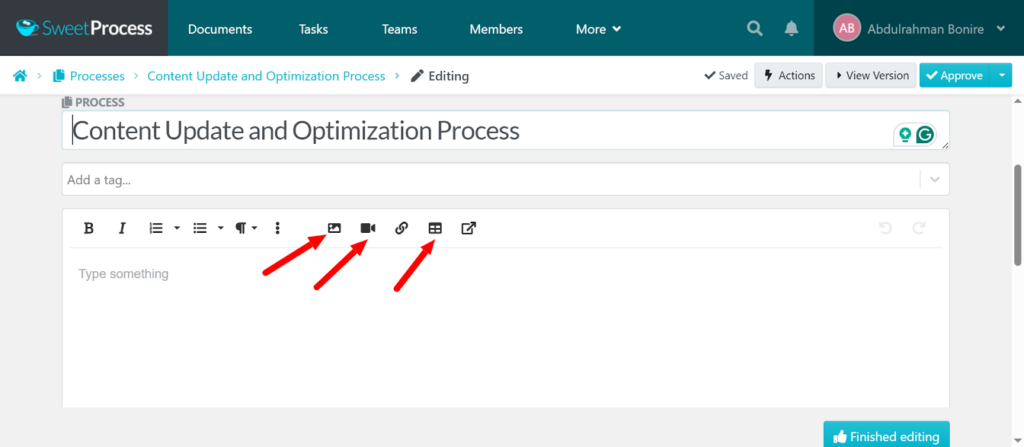
Click “Finished editing” when you are done adding the desired items.
Build an Internal Knowledge Base For Your Employees
Imagine a booming real estate company struggling to maintain efficiency due to outdated operational procedures. Due to operational inefficiency, many evolving businesses struggle to meet their clients’ demands. An example of such was All Residential Estate.
Their experience is a cautionary tale, highlighting the importance of building an internal knowledge base for employees. Before adopting SweetProcess, the company faced significant documentation, training, and consistency issues. The company relied heavily on paper-based checklists and had minimal standardized procedures.
The lack of this detailed and accessible documentation left most employees to figure out processes and procedures independently. It also meant that employees depended on subject matter experts, which always led to delays and bottlenecks.
If a key employee left, their knowledge left with them. This tribal knowledge was creating gaps that slowed operations and impacted service quality. As the real estate industry evolved, the company needed to adapt quickly, but the lack of an easily updatable knowledge system made it challenging to keep pace with changes.
When All Residential Real Estate realized its weaknesses and understood the need to build an internal knowledge base, it adopted SweetProcess, which helped it build a structured digital knowledge base.
After adopting SweetProcess, new hires were onboarded faster, and experienced staff could focus on strategic work instead of answering repetitive process-related questions.
To create an internal knowledge base for your employees, log into your SweetProcess account and click “More” at the top menu.
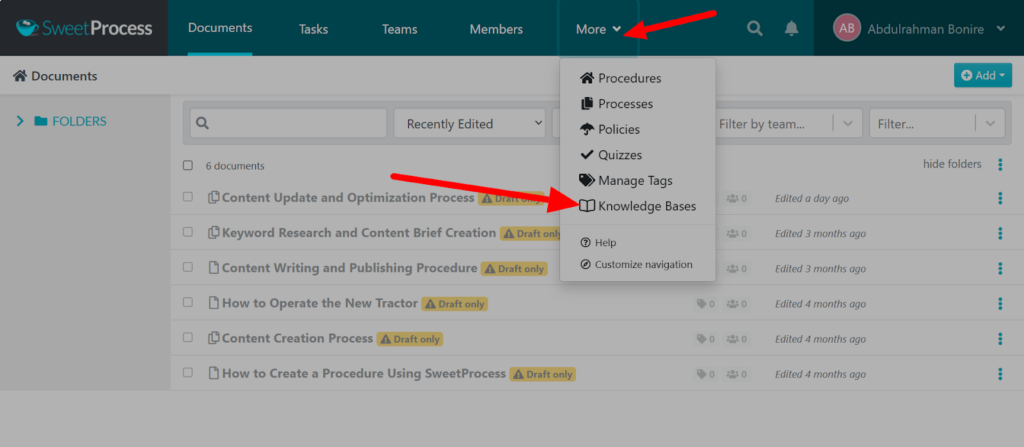
Then click on “Knowledge Bases.” This should take you to a screen similar to the one below.

Give your knowledge base a name and click “Create Knowledge base.”

Your knowledge base will be created; from here, you can make the edits that suit your business needs and branding.
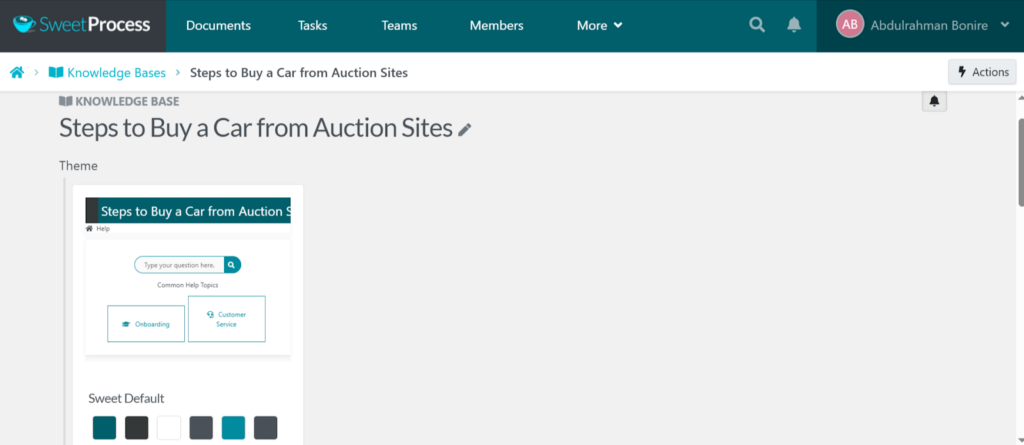
Assign Training Tasks to Employees
Developing practical training in every business is essential to enhance the team’s knowledge and upskilling to perform their roles efficiently and maintain employee productivity. However, manually managing training tasks can be overwhelming, leading to inconsistencies and gaps in knowledge transfer.
If you are struggling with managing your workflow, documenting processes and procedures, and assigning training tasks, SweetProcess is the right tool to streamline your workflow management.
While using SweetProcess, you can create, assign, and manage your business training tasks in a well-detailed and structured manner. By doing that, employees will have access to transparent, step-by-step instructions without creating any confusion. This will provide a standardized learning experience that provides clarity, which helps knowledge retention.
This knowledge retention enables team members to perform tasks confidently and reduce or manage the error margin.
Moreover, onboarding new employees becomes seamless as they can familiarize themselves with the company’s processes.
To assign a task in SweetProcess, go to your account, click “Tasks,” and then click “Assign Task.”

You’ll see a screen similar to the one below.
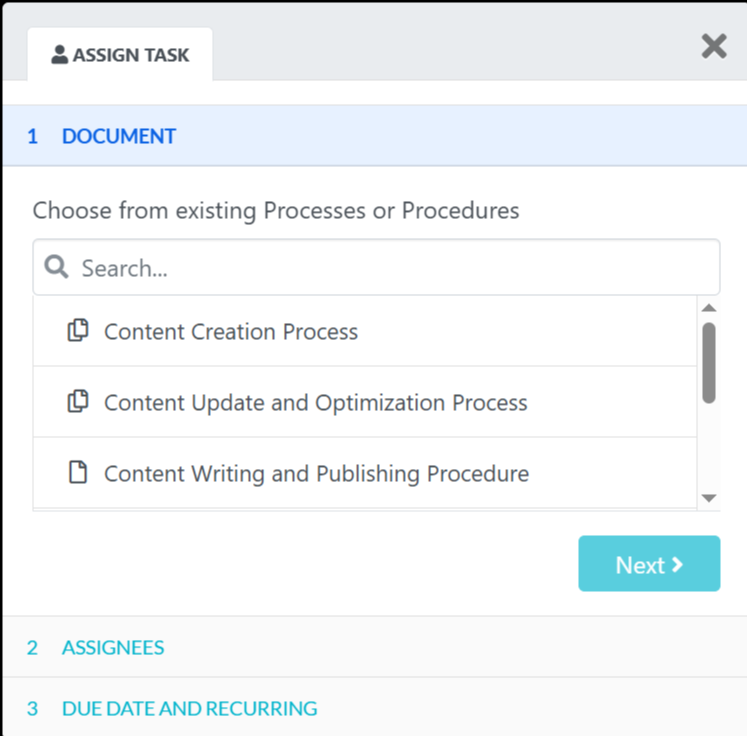
You can assign a task from your existing procedures or process, select the assignees, and set the task due date. You’ll then receive automatic notifications so that you never miss an update.
Why Are Training Materials Important for a Business

Training materials are undoubtedly an organization’s basic asset. They help business owners upskill their employees, manage tribal knowledge, streamline the employee onboarding process, and safeguard their brands’ reputation and operational excellence.
Training materials are important for ensuring a wide range of business productivity while ensuring a well-equipped and informed team with goals that align with the company’s goals. The following are some of the important reasons to craft effective training materials for employees:
Skills Development
Well-structured and detailed training material helps business owners onboard and boost their employees’ workflow. This enables employees to refine their skills and increase organizational productivity. For example, a company focusing on investing in a training program often identifies the relationship between skill development and an improved business outcome.
Knowledge Transfer
Well-detailed training material helps business owners transfer knowledge from experienced professionals to less experienced staff or new employees during or after the hiring process. The knowledge transferred helps business owners secure critical information, best practices, and organizational know-how, which are maintained and disseminated effectively, reducing the risk of knowledge loss due to employee turnover.
Ensuring Consistency in Training Delivery
While ensuring consistency in training delivery using standard training materials, all employees can have the same information, which leads to uniformity while executing tasks and service delivery. This consistency is crucial for maintaining quality and meeting organizational standards across all departments.
Standardization
Training materials that show impeccable processes and procedures with unified training materials frameworks promote organizational standards, brands, and reputation. These unified training materials frameworks help reduce errors, improve productivity, and ensure that all team members align with the organization’s operational process and procedures.
Engagement
Employees’ training materials help make learning interactive, boost employee morale and productivity, motivate them, and enhance their engagement. These engagements help employees be more committed to their roles, leading to higher retention rates and a more productive workplace culture.
Aligning Training With Organization Goals and Objectives
A well-tailored employee training manual serves as an emblem representing the company’s goals. This tends to help workers’ development and the organization’s success. This alignment will likely promote the company’s achievement of its long-term objectives.
Reference
Employee training manuals are more like reference tools or guides that employees consult when they need help.
Saving Time
During the onboarding process for new employees, providing a well-structured SOP Manual can significantly save time and enhance productivity. By offering clear instructions and standardized procedures, businesses can reduce the need for repetitive training sessions and streamline resource allocation.
This approach not only fosters efficiency but also ensures that employees quickly adapt to their roles, minimizing delays in workflow.
Making Training Measurable
Structured training programs with explicit materials enable organizations to measure the effectiveness of their training initiatives, assess employee progress, and identify areas for improvement.
Improving Compliance
Detailed training materials promote employees’ compliance standards, reducing the risk of legal issues and enhancing the company’s reputation in companies with stringent regulatory requirements.
Defining Roles and Responsibilities
Detailed employee training materials that define and outline specific work roles and responsibilities help businesses avoid confusion and overlapping functions and foster an organized and efficient work environment.
Examples of Training Materials To Create for Your Business
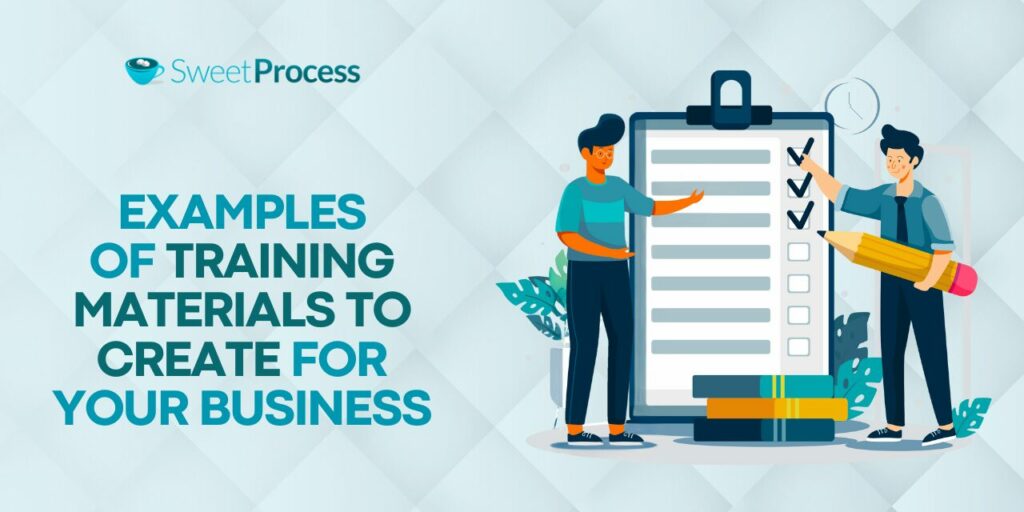
Developing effective employee training materials is important for upskilling, improving productivity, and ensuring compliance with industry standards.
It doesn’t matter whether you’re developing a structured employee training program or looking to improve employee engagement through professional development; having the right training content is crucial. Below are examples of training materials you can create for your business, tailored to different aspects of employee development.
Healthcare Training Materials
Healthcare professionals require well-structured training programs to ensure patient safety, compliance, and operational efficiency. Healthcare training materials may include:
- Compliance training on HIPAA regulations and workplace safety
- Training videos demonstrating proper medical procedures
- Training manuals covering patient care and emergency protocols
- Online training for telemedicine and electronic health records (EHR) systems
Marketing Training Materials
Marketing teams need effective training resources to stay ahead in a competitive landscape. Examples of marketing training materials include:
- Instructional design guides on content creation and branding
- Training programs on SEO, digital marketing, and social media strategies
- Training activity modules on customer engagement and analytics
Emotional Intelligence Training Materials
Developing emotional intelligence is key to improving workplace relationships and leadership. Training materials may cover:
- Training course material on self-awareness and empathy
- Training sessions on stress management and resilience
- Online training modules on communication and conflict resolution
Diversity and Inclusion Training Materials
A well-rounded corporate training program should include diversity and inclusion training to foster a more inclusive work environment. Examples include:
- Training videos on unconscious bias and cultural competency
- Employee training programs promoting unbiased workplace practices
- Learning objectives focused on fostering an inclusive company culture
Safety Training Materials
Safety training is critical in the manufacturing, construction, and healthcare industries. Examples include:
- Workplace safety guides and compliance training manuals
- Employee training materials for handling hazardous materials
- Training needs assessments to improve existing safety protocols
Sales Training Materials
Sales teams require continuous training to stay competitive and improve employee performance. Examples of sales training materials include:
- Training course guides on sales techniques and negotiation skills
- Online training modules for customer relationship management (CRM) and lead conversion
- Employee training materials focusing on customer relationship management
Customer Service Training Materials
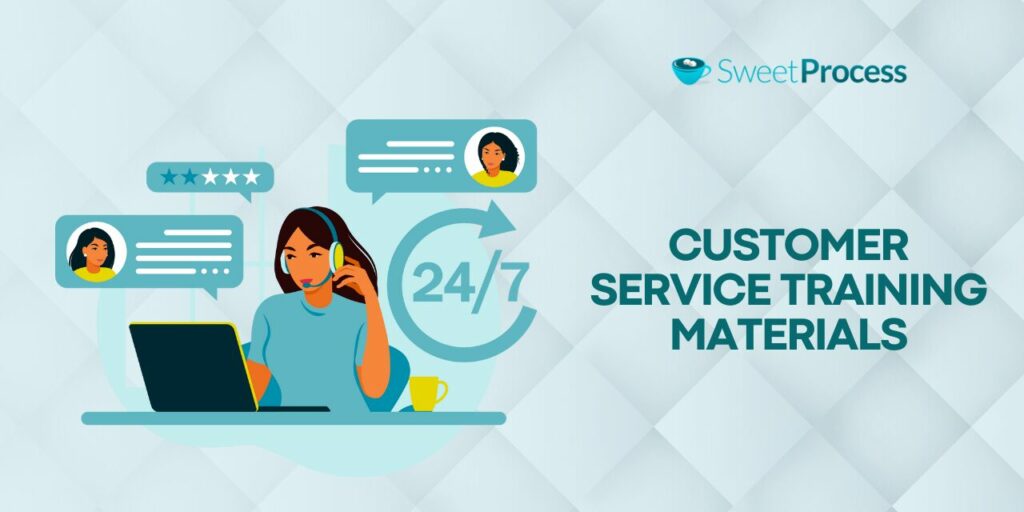
Customer service training programs help employees develop problem-solving skills and promote the customer experience. Some of the important materials include:
- Training manuals with communication strategies and best practices
- Training videos exhibiting customer interaction scenarios
- Effective training materials that focus on handling complaints and escalations
Leadership Training Materials
Leadership training is necessary for emerging future managers and executives. Examples include:
- Management training courses on decision-making and strategic planning
- Training programs that embrace team motivation, coaching, and improved business productivity
- Leadership training materials focused on providing practical communication and representation
HR Training Materials
Human resources (HR) training ensures employees adhere to employment laws and enhances employee engagement. Examples include:
- Corporate training materials on organization policies and workplace ethics
- Training resource guides that manage the employees’ hiring process, onboarding process, and employees’ productivity
- Employee training program materials that focused on conflict resolution and team management
Soft Skills Training Materials
Soft skills training strengthens employees’ interpersonal skills, fostering teamwork and improving productivity. Examples include:
- Soft skills training resources aid timely communication, time management, and adaptability
- Training effectiveness assessments to measure progress
- Different learning styles guide to ensure engagement for all employees
Creating and managing your training materials has never been easier. With SweetProcess, you can streamline the development of employee training programs, improve training effectiveness, and ensure your employees receive the best corporate training experience.
5 Characteristics of Effective Training Materials

Well-designed training materials for employees help organizations improve skill levels, enhance employee engagement, and increase workplace productivity. The Association for Talent Development established that companies investing in employee training and development programs experience a 218 percent higher income per employee than those that don’t.
Below are the top characteristics of an effective training material.
Clear and Concise
Effective training materials should be easy to understand and free of unnecessary complexity. Employees should be able to quickly grasp key concepts without feeling overwhelmed. According to a Forbes business report, the Research Institute of America found that clear and structured e-learning training course material can improve knowledge retention by up to 60 percent.
It is important to ensure clarity of purpose when creating a training manual, online training course, or safety training guide, which will keep learners engaged and help them retain the integral information therein.
Relevant to Learning Objectives and Job Requirements
Training materials must align with specific learning objectives and job roles. A well-structured employee training program ensures employees develop the necessary skills to perform their duties effectively.
According to Harvard Business Review, a 2018 LinkedIn Workplace Learning Report indicated that “94% of employees would stay at a company longer if it invested in their career development”. To achieve practical training, instructional design should focus on providing job-specific knowledge and practical applications that align with business goals.
Engaging and Interesting to Learners
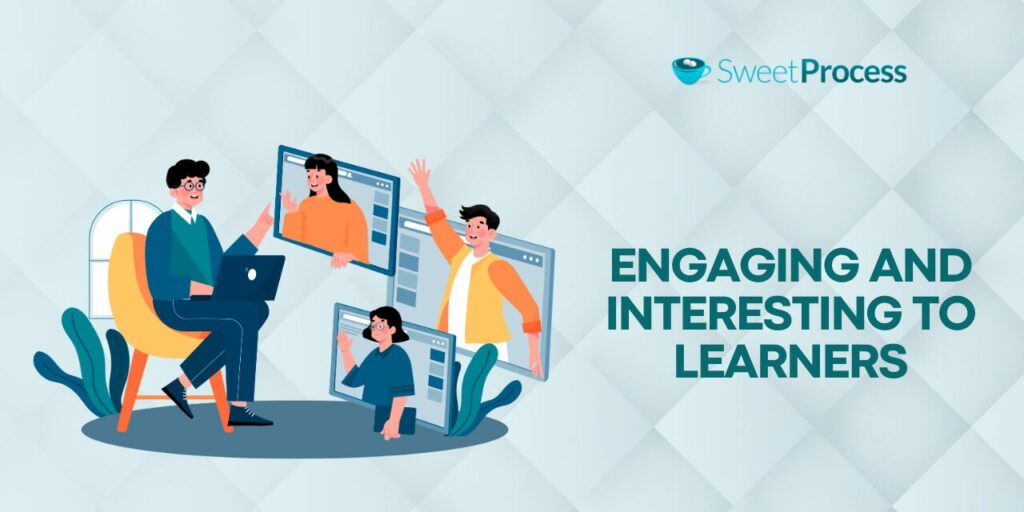
Employees are more likely to retain information when training content is engaging and interactive. A mix of training videos, quizzes, and hands-on activities can make training sessions more dynamic.
According to Vorecol, a study by the University of Warwick suggests “gamified learning increases engagement by up to 50%.” And Code of Talent shares that such programs boost retention by up to 40 percent. Training activities that include practical scenarios and simulations enhance business training effectiveness by giving employees practical experience.
Accessibility in Various Formats
Every learner consumes information differently. Hence, effective training materials should be available in multiple formats to cater to different audiences. Companies using a learning management system (LMS) can offer employee training materials in PDFs, videos, interactive modules, and live sessions. According to a Forbes report, “CIOs that invest in digital adoption platforms and automated learning technologies will see a 40% increase in productivity by 2025.”
Up-to-Date with Current Information and Best Practices
Employee training materials should continually be updated to reflect the latest industry standards, compliance training requirements, and emerging best practices. According to Forbes, outdated training resources reduce training impact, leading to lower employee performance and engagement. However, regular updates to corporate training materials help employees access relevant and actionable knowledge that aligns with organizational goals.
Create and Manage Your Training Materials Using SweetProcess
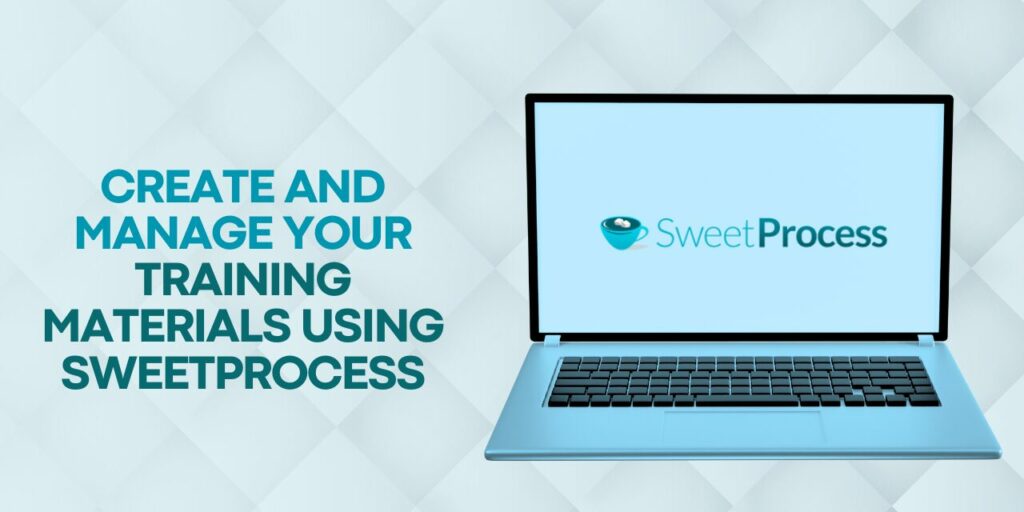
With the right tools, businesses streamline the employee onboarding process and ensure that processes and procedures remain current.
SweetProcess makes this easier by providing a user-friendly tool to manage workflows, create training manuals, and improve operations.
With its user-friendly interface, collaborative traits, and seamless document management features, SweetProcess helps organizations build a strong foundation for knowledge sharing and continuous improvement.
Whether onboarding new employees, documenting standard operating procedures, or refining your existing workflows, SweetProcess ensures that your training materials remain organized and accessible—even on the go.
Don’t let outdated or scattered training resources slow down your team. Start your free trial of SweetProcess today and take the first step toward creating and managing your training materials with ease.
